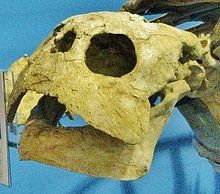| Alienochelys Temporal range: Late
Cretaceous,
| |
|---|---|

| |
| Skull of specimen. | |
|
Scientific classification
| |
| Domain: | Eukaryota |
| Kingdom: | Animalia |
| Phylum: | Chordata |
| Class: | Reptilia |
| Order: | Testudines |
| Suborder: | Cryptodira |
| Family: | † Protostegidae |
| Genus: | †
Alienochelys de Lapparent de Broin, 2014 |
| Type species | |
|
†Alienochelys selloumi de Lapparent de Broin, 2014
| |

Alienochelys ("strange turtle") is an extinct genus of marine turtle known from Maastrichian-aged Cretaceous phosphates in Morocco. [1] With a skull measuring 41.5 centimetres (1.36 ft) long, it would have been a very large turtle. [2] It was first described as a member of the family Dermochelyidae, meaning that it is a relative of the modern leatherback turtle, [2] though a 2018 study identifies it as a sister taxon of Ocepechelon belonging to the family Protostegidae, indicating that it may have been closer to the extinct Archelon. [3] Unlike other sea turtles, Alienochelys' the jaws being adapted for a powerful crushing pattern well adapted for a durophagous lifestyle, as well as its unusual cranial characteristics. [2] [4]
References
- ^ "Fossilworks: Alienochelys". fossilworks.org. Retrieved 17 December 2021.
- ^ a b c de Lapparent de Broin, France; Bardet, Nathalie; Amaghzaz, Mbarek; Meslouh, Saïd (2014). "A strange new chelonioid turtle from the Latest Cretaceous Phosphates of Morocco". Comptes Rendus Palevol. 13 (2): 87–95. doi: 10.1016/j.crpv.2013.07.008.
- ^ Scavezzoni, I.; Fischer, V. (2018). "Rhinochelys amaberti Moret (1935), a Protostegid Turtle from the Early Cretaceous of France". PeerJ. 10 (6): e4594. doi: 10.7717/peerj.4594. PMC 5898427. PMID 29666758.
- ^ Cooper, S.L.A.; Marson, K.J.; Smith, R.E.; Martill, D. (2022). "Contrasting preservation in pycnodont fishes reveals first record of regurgitalites from the Upper Cretaceous (Maastrichtian) Moroccan phosphate deposits". Cretaceous Research. 131 (4). 105111. doi: 10.1016/j.cretres.2021.105111.